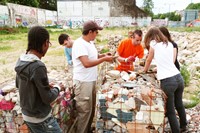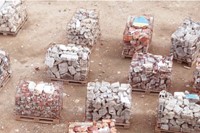Every year the COAL prize is awarded to an outstanding project exploring art and the environment – and with almost 400 submissions from over 40 different countries standards soared in 2011. This year’s winner was Stefan Shankland’s Marbre d’Ici
Every year the COAL prize is awarded to an outstanding project exploring art and the environment – and with almost 400 submissions from over 40 different countries standards soared in 2011. This year’s winner was Stefan Shankland’s Marbre d’Ici (marble from here). Combining art with urban and sustainable development, the project aims to create a new composite material from the rubble of construction sites around cities – forming a local raw material which tells the story of a neighbourhood. Shankland is now collaborating with Raum architects, Materiaupole, Urbicus and the TRANS305 team, and together they are hoping to have the first ‘marble’ construction built in April 2012.
Other commended projects were Art Orienté’s Folia Apotropaica and Ackroyd & Harvey’s Beuys’ Acorns. The first, literally translated as “leaf that conjures the evil eye”, would take place at the rainforest canopy level aboard the White Diamond: a blimp-like creation that silently cruises above the treetops. Invented by London-based aeronautical engineer Dr. Graham Dorrington to study the canopy layer, the aircraft would be used in the artwork to discover a new plant and christen it Folia Apotropaica. Plant-based bioluminescence technology would be injected into tree climbers to temporarily place the name of the new species in huge letters atop the rainforest, imprinting ‘the evil eye’ on satellite records: a poetic wake-up to questions of rainforests, biodiversity and the presence of satellite observatories.
Ackroyd & Harvey, meanwhile, seek to renew Joseph Beuys’ declaration that cities should be ‘like forests’. Following on from Beuys’ initial planting of 7000 oaks across 1 city, they are proposing collecting acorns from these established trees and planting seven million new oaks in cities across England and Europe. Not only would each new tree contribute to reducing net carbon dioxide levels, they will also act as a catalyst for generating a series of public interfaces where people from a multitude of disciplines will explore the fundamental interdependence that links us to the natural world.
The 2012 COAL prize is now open for submissions.
Abigail Schlageter is a member of super/collider, a London-based collective which explores science and ecology through the creative industries.



